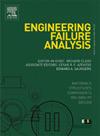Failure behavior in single point incremental forming parts of AA6061-T6
IF 4.4
2区 工程技术
Q1 ENGINEERING, MECHANICAL
引用次数: 0
Abstract
Single point incremental forming (SPIF) forms 3D components using a hemispherical tool without needing a component-specific die/punch. Although SPIF is proven to enhance material formability, the successful forming of high-strength materials is difficult due to their lower ductility. The current work presents a comprehensive failure analysis of SPIF components through detailed experiments, microscopic and fractographic investigation, and finite element (FE) simulations. Frustum cone and pyramid components with different wall angles are formed using SPIF. Comprehensive experiments reveal that frustum cones can be successfully formed up to higher wall angles than frustum pyramids due to plane-strain deformation. Although the varying corner radius (VCR) pyramids can be formed at higher wall angles than the constant corner radius (CCR) pyramids, they tend to fail at different orientations on the same wall angle. FE simulations are performed to correlate the fracture of the components with strain accumulation and sheet thinning. Microscopic examination of the crack regions is performed to gain insight into the components’ damage, crack initiation, and propagation. Damage along circumferential direction is observed in already formed regions due to bending and stretching during previous tool passes. Additionally, in higher wall angles (60° and 50°) VCR pyramids, the damage is observed along the meridional direction, contributing to crack initiation. The crack is primarily initiated for 45° VCR and CCR pyramid due to tensile meridional stresses. Moreover, crack propagation is primarily driven by tensile meridional stresses, but shear also plays a role due to tool movement in all cases.
AA6061-T6单点增量成形件失效行为
单点增量成形(SPIF)使用半球形工具形成3D部件,而不需要部件特定的模具/冲床。尽管SPIF已被证明可以提高材料的成形性,但由于高强度材料的延展性较低,因此很难成功成形。目前的工作通过详细的实验、微观和断口研究以及有限元(FE)模拟,对SPIF组件进行了全面的失效分析。利用SPIF形成不同壁角的截锥体和锥体构件。综合实验表明,由于平面应变变形,锥体可以比锥体成功形成更高的壁角。虽然变角半径(VCR)金字塔比恒角半径(CCR)金字塔可以在更高的壁角下形成,但在相同的壁角下,它们往往在不同的方向上失效。进行了有限元模拟,将构件的断裂与应变积累和薄板变薄联系起来。对裂纹区域进行微观检查,以深入了解部件的损伤、裂纹起裂和扩展。在之前的刀具加工过程中,由于弯曲和拉伸,在已经成形的区域沿周向观察到损伤。此外,在较高的壁角(60°和50°)VCR金字塔中,沿子午方向观察到损伤,有助于裂纹的起裂。裂缝主要在45°VCR和CCR锥体处由经向拉应力引起。此外,裂纹扩展主要是由拉伸子午应力驱动的,但在所有情况下,由于刀具运动,剪切也起作用。
本文章由计算机程序翻译,如有差异,请以英文原文为准。
求助全文
约1分钟内获得全文
求助全文
来源期刊

Engineering Failure Analysis
工程技术-材料科学:表征与测试
CiteScore
7.70
自引率
20.00%
发文量
956
审稿时长
47 days
期刊介绍:
Engineering Failure Analysis publishes research papers describing the analysis of engineering failures and related studies.
Papers relating to the structure, properties and behaviour of engineering materials are encouraged, particularly those which also involve the detailed application of materials parameters to problems in engineering structures, components and design. In addition to the area of materials engineering, the interacting fields of mechanical, manufacturing, aeronautical, civil, chemical, corrosion and design engineering are considered relevant. Activity should be directed at analysing engineering failures and carrying out research to help reduce the incidences of failures and to extend the operating horizons of engineering materials.
Emphasis is placed on the mechanical properties of materials and their behaviour when influenced by structure, process and environment. Metallic, polymeric, ceramic and natural materials are all included and the application of these materials to real engineering situations should be emphasised. The use of a case-study based approach is also encouraged.
Engineering Failure Analysis provides essential reference material and critical feedback into the design process thereby contributing to the prevention of engineering failures in the future. All submissions will be subject to peer review from leading experts in the field.
 求助内容:
求助内容: 应助结果提醒方式:
应助结果提醒方式:


